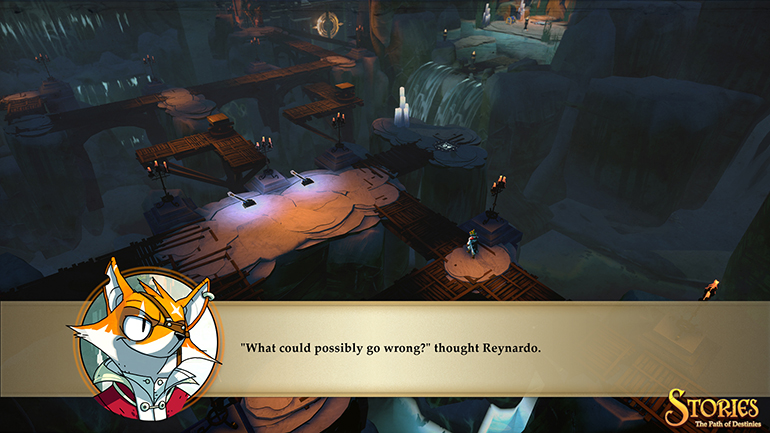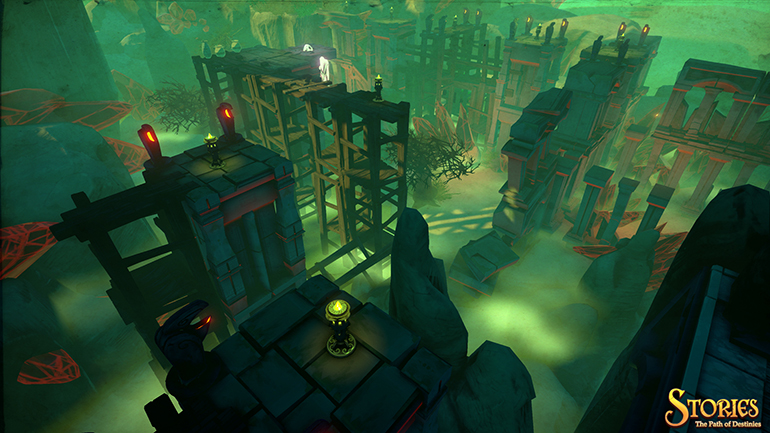Stories: The Path of Destinies - Unconventional Fantasy Tales Come to Life with Unreal Engine 4
When the world needs saving, there’s always a hero ready to risk it all in the name of the greater good. A brave and noble champion who fearlessly jumps into battle to protect the realm from evil. And even when the odds are overwhelming, the hero finds a way to defeat the monstrous threat and restore peace to the people.
That’s usually how storybooks go, but Montreal-based Spearhead Games is crafting a very different experience with Stories: The Path of Destinies, one that has little in common with fairytales beyond the color palette. Depending on player choice, the tales in Stories can go in completely unexpected directions. Expecting a light, cheery plot with chivalric romance? How about one in which you become possessed and slay all of your loved ones? On top of that, a prodding narrator accompanies you each step of the way, sometimes poking fun at your mishaps.
And how to best describe the hero, Reynardo? Dashing fox, ex-pirate, pretend scholar. Totally not in love with a cat he met in Sword Fu school years ago. Unquestionably full of himself.
Through a series of circumstances he’d rather forget, Reynardo was swept up in the Rebellion, the only forces left to fight back against the mad Emperor whose nefarious plans threaten to wipe out the entire realm of Boreas. Worse still, the decisive battle is quickly approaching and if Reynardo falls, the Rebellion is history.
Fortunately, the pirate life taught Reynardo a few things. Bribery, theft and speedy getaways are all second nature to him. Except now the stakes are much higher and it’s a little too late to flee. But wait! As the hero of the story, Reynardo must have some sort of plan up his sleeve, right?
Sure he does. He even has more than one. And they’re all really great (according to him).
Nevermind the fact that Reynardo’s ideas have the spectacularly common tendency of going absolutely, terrifyingly wrong. He’s got this.
Obviously, the tale being presented in Stories: The Path of Destinies is intriguing enough, but there's an actual game to build here too. That's why we reached out to Spearhead Games to inquire about both the creative and technical aspects of this compelling project.

What kind of game is Stories: The Path of Destinies? Why did you choose to build it using Unreal Engine 4?
Atul Mehra, Co-Founder: Stories: The Path of Destinies is an action-RPG containing a variety of fantasy tales all narrated to the player. The stories are part of an enchanted storybook, one Reynardo also uses to travel back in time and fix his mistakes.
In Stories, each choice the player makes throughout Reynardo’s journey leads not only to different endings, but to different narratives altogether. There are dozens of entirely different tales created by the player’s decisions. These stories range from tongue-in-cheek takes on classic hero adventures and poignant romance to dark, Lovecraftian turnabouts. Stories’ narrative system is all about applying the knowledge gained from these independent arcs to lead Reynardo to victory.
Having worked in UE3 for over two years, UE4 was our next logical choice. At the start we did not realize the true benefit of this migration. As we dove into the engine and started to explore its various new features, we realized that the new tools released us from the dependencies between various groups and empowered each of our team members to be able to do a lot more and to do it a lot quicker.
Spearhead’s previous game, Tiny Brains, was a co-op puzzle game made with a previous iteration of Unreal Engine. How difficult was it to transition to a much more ambitious project like Stories?
Jerome Parent, Designer: UE4’s intuitive Blueprint system gave us the tools to prototype extremely quickly and efficiently, as well as the ability to take those prototypes to production quality much more rapidly than we would have been able to in Unreal Engine 3. This allowed Stories to have a significantly bigger scope and higher level of polish than our previous games, with the same amount of development time, even though we were also learning a new engine.

Majestic airships, shiny treasure and magic-imbued swords are just some of the things that populate Boreas. How has Unreal Engine 4 helped craft the colorful fantasy world players will explore in Stories?
Yan Mongrain, Art Director: Most of the art tools in UE4 are more accessible and played a huge role in our ability to create a more cohesive artistic world. The new lighting and post-process systems helped to prototype various moods and styles quickly. We used the dynamic lighting feature to create different light schemes, and in the beginning, prototype dynamic lighting situations. The shader editor is also now easier than ever to use and also helped us quickly bring the game to life. The addition of physically based rendering made our world seem a little more accessible.
Maximilien Faubert, VFX Artist: In an unprecedented manner UE4 allowed us to design complex effects and link them directly to the exposed parameters within Blueprint. The gap between art and technology has gotten smaller and this has allowed us to move faster in the iteration process.
The evil Emperor unleashes tons of baddies on Reynardo, but as an ex-pirate and Sword Fu master, our foxy protagonist knows how to lay on the pain. What were some of the ways UE4 helped forge Stories’ satisfying gameplay and combat?
Thierry Van Elsuwe, Programmer: Working with Unreal Engine 4 and its amazing Hot Reload feature, we were able to do multiple iterations very fast while still keeping the speed of native code. And with all the built-in features, we could really concentrate our efforts on the core gameplay. Also, thanks to Blueprint's easy integration with C++ (and vice versa), we could delegate lots of the game logic work to the designers and concentrate on the more difficult tasks.
In line with choose-your-own-adventure books from the good ol’ days, a lot of Reynardo’s choices are going to turn out, well, pretty disastrous. What were some of the challenges of building the intricate narrative system, and did UE4 address any of them?
Philip Tam, Designer: The amount of recorded lines for all the story variants was massive. And to add to the complexity, we also had the narrator react differently depending on certain actions Reynardo did. But thanks to Blueprint and the importing and exporting tools introduced in UE4, we could easily and quickly integrate, test and modify the thousands of lines of the game.
What is your favourite feature or tool in UE4, and why is Stories better for it?
Mathieu Bissonnette, Designer: It would have to be Blueprint. Having worked for many years with UE3 as well as other engines, UE4 was a true breath of fresh air and a real revolution in term of possibilities for any designers and artists. Not only does Blueprint make every part of the game development process accessible, it also accelerates it! A team of 10 can do what 50 used to do, all while being truly in control of the creative process.

Stories: The Path of Destinies releases April 12, 2016 for PlayStation 4 and PC. Save 10% off when you pre-order on the PlayStation Store.
Follow Stories on Twitter and Facebook to keep up with the latest news.